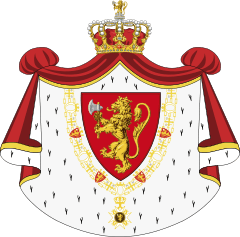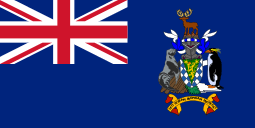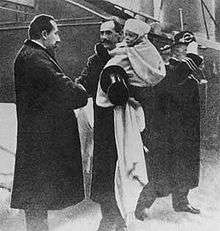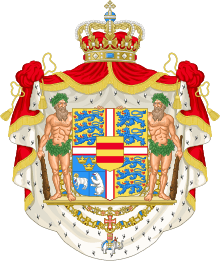Olav V of Norway
| Olav V | |||||
|---|---|---|---|---|---|
 | |||||
| King of Norway | |||||
| Reign | 21 September 1957 – 17 January 1991 | ||||
| Benediction[1] | 22 June 1958 | ||||
| Predecessor | Haakon VII | ||||
| Successor | Harald V | ||||
| Prime Ministers | |||||
| Born |
2 July 1903 Sandringham Estate, Norfolk, United Kingdom | ||||
| Died |
17 January 1991 (aged 87) Kongsseteren in Holmenkollen, Oslo, Norway | ||||
| Burial |
30 January 1991 Akershus Castle, Oslo, Norway | ||||
| Spouse | Princess Märtha of Sweden | ||||
| Issue |
Princess Ragnhild Princess Astrid Harald V of Norway | ||||
| |||||
| House | Glücksburg | ||||
| Father | Haakon VII of Norway | ||||
| Mother | Maud of Wales | ||||
| Religion | Church of Norway | ||||
| Medal record | ||
|---|---|---|
| Sailing | ||
| Representing | ||
| Olympic Games | ||
| | 1928 Amsterdam | 6 m mixed |
| 5.5 Metre World Championships | ||
| | 1971 Seawanhaka | 5.5m |
| | 1976 Hankø | 5.5m |
Olav V (Alexander Edward Christian Frederik; 2 July 1903 – 17 January 1991) was King of Norway from 1957 until his death.
Olav was the only child of Haakon VII and Maud of Wales. He became heir apparent to the Norwegian throne when his father was elected King of Norway in 1905. He was the first heir to the Norwegian throne to be brought up in Norway since Olav IV, and his parents made sure he was given as Norwegian an upbringing as possible. In preparation for his future role, he attended both civilian and military schools. In 1929, he married his first cousin Princess Märtha of Sweden. During World War II his leadership was much appreciated and he was appointed Norwegian Chief of Defence in 1944. At his death in 1991, he was the last surviving grandchild of Edward VII of the United Kingdom and Alexandra of Denmark.
Due to his considerate, down-to-earth style, King Olav was immensely popular, resulting in the nickname Folkekongen ("The People's King"). In a 2005 poll by the Norwegian Broadcasting Corporation, Olav was voted "Norwegian of the century".[2]
Birth and early life

Olav was a Danish prince born in Appleton House on the royal Sandringham Estate, Flitcham, United Kingdom.[3] He was named Alexander Edward Christian Frederik. His parents were Prince Carl, second son of Crown Prince Frederick of Denmark (later King Frederick VIII), and Princess Maud, youngest daughter of King Edward VII of the United Kingdom who was the eldest son of Britain's Queen Victoria. When his father was elected king of Norway, he took the Norwegian name Haakon VII, and on the day he was inaugurated, he gave his son the Norwegian name Olav.[4]
Olav was the first heir to the throne since medieval times to have been raised in Norway. Unlike his father, who was a naval officer, Olav chose to complete his main military education in the army. He graduated from the three-year Norwegian Military Academy in 1924, with the fourth best score in his class. Olav then went on to study jurisprudence and economics for two years at Balliol College, Oxford.[5]
During the 1930s, Crown Prince Olav was a naval cadet serving on the minelayer/cadet training ship Olav Tryggvason.[6] Olav moved upwards in the ranks of the Norwegian armed forces, rising in the army from an initial rank of first lieutenant, to captain in 1931 and colonel in 1936.[7]
He was an accomplished athlete. Olav jumped from the Holmenkollen ski jump in Oslo, and also competed in sailing regattas. He won a gold medal in sailing at the 1928 Summer Olympics[8] in Amsterdam and remained an active sailor into old age.
On 21 March 1929 in Oslo, he married his first cousin Princess Märtha of Sweden with whom he had two daughters, Ragnhild and Astrid and one son, Harald. As exiles during World War II, Crown Princess Märtha and the royal children lived in Washington, D.C., where she struck up a close friendship with Franklin D. Roosevelt. She died in 1954, before her husband ascended the throne.
The British Film Institute houses an early film, made in 1913, in which a miniature car commissioned by Queen Alexandra for the Crown Prince Olav tows a procession of Londoners through the streets of the capital, before being delivered to a pair of 'royal testers' of roughly Olav's age.[9]
World War II
As Crown Prince, Olav had received extensive military training and had participated in most major Norwegian military exercises. Because of this he was perhaps one of the most knowledgeable Norwegian military leaders and was respected by other Allied leaders for his knowledge and leadership skills. During a visit to the United States before the war, he and his wife had established a close relationship with President Roosevelt. These factors would prove to be important for the Norwegian fight against the attacking German forces.
In 1939, Crown Prince Olav was appointed an admiral of the Royal Norwegian Navy and a general of the Norwegian Army.[7]
During World War II, Olav stood by his father's side in resisting the occupation of Norway by Nazi Germany. During the campaign he was a valuable advisor both to civilian and military leaders. When the Norwegian government decided to go into exile, he offered to stay behind with the Norwegian people, but this was declined. He reluctantly followed his father to the United Kingdom, where he and his staff and servants and aides continued to be a key advisor to the government-in-exile and his father. It is a popular legend among his countrymen that he did not allow himself any dessert or sweets for the duration of the Norwegian occupation.
Olav made several visits to Norwegian and Allied troops in the United Kingdom, Canada and the United States. In 1944, he was appointed to the post of Norwegian Chief of Defence and after the war he led the Norwegian disarmament of the German occupying forces. His war decorations from other nations, including the War Crosses of Norway, France, Greece and the Netherlands, the US Legion of Merit and the French Médaille Militaire, are testament to the international recognition of his contribution to the war against Hitler.
| Norwegian Royalty House of Oldenburg (Glücksburg branch) |
|---|
 |
| Haakon VII |
|
| Olav V |
| Harald V |
|
Reign

Succeeding to the Norwegian throne in 1957 upon his father's death, Olav reigned as a "People's King," and became extremely popular. He liked to drive his own cars, and would drive in the public lanes, even though as a monarch he was allowed to drive in bus lanes. During the 1973 energy crisis driving was banned on certain weekends. King Olav never wanted to miss an opportunity to go skiing, and while he could have driven legally, he wanted to lead by example. So he dressed up in his skiing outfit, and boarded the Holmenkollbanen suburban railway carrying his skis on his shoulder.[10] He was later asked how he dared to go out in public without bodyguards. He replied that "he had 4 million bodyguards" —the population of Norway was at the time 4 million.
For his athletic ability and role as King, Olav V earned the Holmenkollen medal in 1968. He had a strong interest in military matters and took his role as titular Commander-in-Chief very seriously. As well as his ceremonial roles in the Norwegian Army, he also served as Colonel-in-Chief of the Green Howards (Alexandra, Princess of Wales's Yorkshire Regiment), the British regiment named for his grandmother Queen Alexandra.
The King represented Norway extensively abroad during his reign, conducting state visits to both neighbouring countries and more distant destinations such as Ethiopia.
King Olav V opened the 14th World Scout Jamboree in July 1975 in the presence of 17,259 Scouts from 94 countries.
Illness and death
During the summer of 1990, the King suffered from health problems, but recovered somewhat during Christmas the same year. At the age of 87, on 17 January 1991, while residing in the Royal Lodge Kongsseteren in Oslo, he became ill and died in the evening of a myocardial infarction. An interview given by King Harald V, and hints in a biography by Jo Benkow, who was the president of the parliament in that time, mention the possibility that King Olav suffered great trauma upon learning of the outbreak of the first Gulf War, which began the day of his death. Olav's son Harald V succeeded him as King.
The night after he died (and for several days up until the state funeral), Norwegians mourned publicly, lighting hundreds of thousands of candles in the courtyard outside the Royal Palace in Oslo, with letters and cards placed amongst them. The National Archives have preserved all these cards.
Olav and his wife Märtha are buried in the green sarcophagus in the Royal Mausoleum at Akershus Fortress.
Titles, styles and honours
| Styles of King Olav V of Norway | |
|---|---|
|
| |
| Reference style | His Majesty |
| Spoken style | Your Majesty |
| Alternative style | Sir |
Titles and styles
- 2 July 1903 – 18 November 1905: His Highness Prince Alexander of Denmark
- 18 November 1905 – 21 September 1957: His Royal Highness The Crown Prince of Norway
- 21 September 1957 – 17 January 1991: His Majesty The King of Norway
Orders and medals
-
 Norway War Cross
Norway War Cross -
 Norway Medal for Outstanding Civic Achievement in gold
Norway Medal for Outstanding Civic Achievement in gold -
 Norway Grand Cross with Collar of the Royal Norwegian Order of St Olav (later Grand Master)
Norway Grand Cross with Collar of the Royal Norwegian Order of St Olav (later Grand Master) -
 Norway Grand Cross of the Royal Norwegian Order of Merit (Grand Master)
Norway Grand Cross of the Royal Norwegian Order of Merit (Grand Master) -
 Norway St Olav's medal
Norway St Olav's medal -
 Norway Coronation Medal of 1906
Norway Coronation Medal of 1906 -
 Norway War Medal (Norway)
Norway War Medal (Norway) -
 Norway Haakon VII 70th Anniversary Medal
Norway Haakon VII 70th Anniversary Medal -
 Norway King Haakon VII 1905–1955 Jubilee Medal
Norway King Haakon VII 1905–1955 Jubilee Medal -
 Argentina Grand Cross with Collar of the Order of the Liberator General San Martin
Argentina Grand Cross with Collar of the Order of the Liberator General San Martin -
 Austria Grand Star of the Decoration of Honour for Services to the Republic of Austria
Austria Grand Star of the Decoration of Honour for Services to the Republic of Austria -
.svg.png) Belgium Grand Cordon of the Order of Leopold
Belgium Grand Cordon of the Order of Leopold -
 Brazil Grand Cross with Collar of the Order of the Rose
Brazil Grand Cross with Collar of the Order of the Rose -
 Chile Grand Cross with Collar of the Order of the Merit of Chile
Chile Grand Cross with Collar of the Order of the Merit of Chile -
 Denmark Knight of the Elephant
Denmark Knight of the Elephant -
 Denmark Grand Commander of the Order of the Dannebrog
Denmark Grand Commander of the Order of the Dannebrog -
 Denmark King Christian X's Freedom Medal
Denmark King Christian X's Freedom Medal -
 Denmark Commemorative Medal for King Christian IX's 100th birthday
Denmark Commemorative Medal for King Christian IX's 100th birthday -
 Denmark Commemorative Medal for King Frederik VIII's 100th birthday
Denmark Commemorative Medal for King Frederik VIII's 100th birthday -
.svg.png) Ethiopia Grand Cross of the Order of Solomon
Ethiopia Grand Cross of the Order of Solomon -
 Finland Grand Cross of the Order of the White Rose
Finland Grand Cross of the Order of the White Rose -
 France Grand Croix of the Légion d'honneur
France Grand Croix of the Légion d'honneur -
 France Croix de guerre
France Croix de guerre -
 France Médaille militaire
France Médaille militaire -
 Germany Grand Cross Special Class of the Order of Merit of the Federal Republic of Germany
Germany Grand Cross Special Class of the Order of Merit of the Federal Republic of Germany -
 Great Britain Stranger Knight of the Garter (923rd member)
Great Britain Stranger Knight of the Garter (923rd member) -
 Great Britain Knight of the Thistle[11]
Great Britain Knight of the Thistle[11] -
 Great Britain Honorary Knight Grand Cross of the Order of the Bath
Great Britain Honorary Knight Grand Cross of the Order of the Bath -
 Great Britain Recipient of the Royal Victorian Chain
Great Britain Recipient of the Royal Victorian Chain -
 Great Britain Honorary Knight Grand Cross of the Royal Victorian Order
Great Britain Honorary Knight Grand Cross of the Royal Victorian Order -
 Great Britain Recipient of the King George V Silver Jubilee Medal
Great Britain Recipient of the King George V Silver Jubilee Medal -
 Great Britain Recipient of the King George VI Coronation Medal
Great Britain Recipient of the King George VI Coronation Medal -
 Great Britain Recipient of the Queen Elizabeth II Coronation Medal
Great Britain Recipient of the Queen Elizabeth II Coronation Medal -
.svg.png) Greece Grand Cross of the Order of the Redeemer
Greece Grand Cross of the Order of the Redeemer -
.svg.png) Greece Grand Cross of the Order of St. George and St. Constantine
Greece Grand Cross of the Order of St. George and St. Constantine -
.svg.png) Greece War Cross 1940
Greece War Cross 1940 -
.svg.png) Iran Grand Cordon of the Order of Pahlavi
Iran Grand Cordon of the Order of Pahlavi -
.svg.png) Iran Commemorative Medal of the 2500th Anniversary of the founding of the Persian Empire (14/10/1971).[12]
Iran Commemorative Medal of the 2500th Anniversary of the founding of the Persian Empire (14/10/1971).[12] -
 Iceland Grand Cross (1955) with Collar (1961) of the Order of the Falcon
Iceland Grand Cross (1955) with Collar (1961) of the Order of the Falcon -
 Japan Collar of the Order of the Chrysanthemum
Japan Collar of the Order of the Chrysanthemum -
 Luxembourg Knight of the Order of the Gold Lion of the House of Nassau
Luxembourg Knight of the Order of the Gold Lion of the House of Nassau -
 Mexico Grand Cross of the Order of the Aztec Eagle
Mexico Grand Cross of the Order of the Aztec Eagle -
 Netherlands Grand Cross of the Order of the Netherlands Lion
Netherlands Grand Cross of the Order of the Netherlands Lion -
 Netherlands Grand Cross of the Order of the House of Orange
Netherlands Grand Cross of the Order of the House of Orange -
 Netherlands War Cross
Netherlands War Cross -
 Netherlands Medaille d'Installation Solennelle 1948
Netherlands Medaille d'Installation Solennelle 1948 -
 Peru Grand Cross of the Order of the Sun
Peru Grand Cross of the Order of the Sun -
 Portugal Grand Cross of the Order of St. Bento d'Aviz
Portugal Grand Cross of the Order of St. Bento d'Aviz -
 Portugal Grand Collar of the Order of Saint James of the Sword
Portugal Grand Collar of the Order of Saint James of the Sword -
.svg.png) Romania Knight Grand Cross of the Order of the Star
Romania Knight Grand Cross of the Order of the Star -
 Saxony Grand Cross of the Ernestine Order (Saxony, Germany)
Saxony Grand Cross of the Ernestine Order (Saxony, Germany) -
 Spain Collar of the Order of the Golden Fleece
Spain Collar of the Order of the Golden Fleece -
 Spain Grand Cross Collar of the Order of Charles III
Spain Grand Cross Collar of the Order of Charles III -
 Sweden Knight of the Seraphim
Sweden Knight of the Seraphim -
 Sweden King Gustaf V's 70th Anniversary Medal
Sweden King Gustaf V's 70th Anniversary Medal -
 Sweden King Gustaf V's 90th Anniversary Medal
Sweden King Gustaf V's 90th Anniversary Medal -
 Thailand Knights of the Order of the Royal House of Chakri
Thailand Knights of the Order of the Royal House of Chakri -
 Thailand Knight Grand Cross of the Most Illustrious Order of Chula Chom Klao
Thailand Knight Grand Cross of the Most Illustrious Order of Chula Chom Klao -
 Tunisia Grand Cross of the Order of Independence
Tunisia Grand Cross of the Order of Independence -
 USA Chief Commander of the Legion of Merit
USA Chief Commander of the Legion of Merit -
 Yugoslavia Order of the Yugoslav Great Star[13]
Yugoslavia Order of the Yugoslav Great Star[13]
Other honours
-
 Norway A 180 000 km² area (Prince Olav Coast) and the Prince Olav Mountains in Antarctica are named in his honour.
Norway A 180 000 km² area (Prince Olav Coast) and the Prince Olav Mountains in Antarctica are named in his honour. -
 Norway Olav V Land on Svalbard is named in his honour.
Norway Olav V Land on Svalbard is named in his honour. -
 Norway In 1961 the King was a laureate of the Nansen Refugee Award.
Norway In 1961 the King was a laureate of the Nansen Refugee Award. -
 Norway In 1968 he was awarded the Holmenkollen medal.
Norway In 1968 he was awarded the Holmenkollen medal. -
 Norway In 2005, Olav was proclaimed the Norwegian of the Century, with 41 percent of the tele-votes in a popular competition held by NRK.
Norway In 2005, Olav was proclaimed the Norwegian of the Century, with 41 percent of the tele-votes in a popular competition held by NRK. -
 United Kingdom In 1959, Olav was granted the honorary rank of Air Chief Marshal in the Royal Air Force.[14]
United Kingdom In 1959, Olav was granted the honorary rank of Air Chief Marshal in the Royal Air Force.[14] -
 United Kingdom In 1988, Olav was granted the honorary rank of Admiral of the Fleet in the Royal Navy.
United Kingdom In 1988, Olav was granted the honorary rank of Admiral of the Fleet in the Royal Navy. -
 United Kingdom Honorary Freeman of Richmond
United Kingdom Honorary Freeman of Richmond -
 United Kingdom – Honorary Freedom of Newcastle upon Tyne[15]
United Kingdom – Honorary Freedom of Newcastle upon Tyne[15] -
 South Georgia and the South Sandwich Islands Prince Olav Harbour on South Georgia is also named in his honour.
South Georgia and the South Sandwich Islands Prince Olav Harbour on South Georgia is also named in his honour.
-
 Norway Member of the Independent Order of Odd Fellows.[16]
Norway Member of the Independent Order of Odd Fellows.[16]
Ancestors
Gallery

Crown Prince Olav arrives in Norway in 1905 on his father's arm and is greeted by Prime Minister Christian Michelsen 
Drawing, 1906, by Andreas Bloch  Märtha and Olav on the cover of Time on the occasion of their wedding
Märtha and Olav on the cover of Time on the occasion of their wedding
Crown Prince Olav and his father King Haakon VII take shelter under birch trees as the German Luftwaffe bombs Molde 
Märtha and Olav in 1950. 
Olav in 1921 as Crown Prince.  Haakon VII of Norway, Maud of Wales and Crown Prince Olav on 17 July 1913 in Norway
Haakon VII of Norway, Maud of Wales and Crown Prince Olav on 17 July 1913 in Norway
References
- ↑ Coronation discarded by constitutional amendment in 1908. Olaf V instead received benediction in Nidaros Cathedral.
- ↑ "Folkekongen ble århundrets nordmann". Aftenposten (in Norwegian). 17 December 2005. Retrieved 14 July 2011.
- ↑ Sandelson, Michael (28 October 2011). "Norway's Queen Maud in euthanasia speculations". The Foreigner. Retrieved 9 July 2013.
- ↑ "Olav to Martha". Time Magazine. 21 January 1929. Retrieved 17 January 2009.
- ↑ Benkow 1991, pp. 97-108
- ↑ Bratli 1995, p. 93
- 1 2 Dahl 1982, p. 48
- ↑ http://www.nytimes.com/1991/01/18/obituaries/olav-v-norway-s-king-33-years-and-resistance-hero-dies-at-87.html
- ↑
- ↑ Article from NRK on the king Featuring a photo of the event and explanatory text (Norwegian). Retrieved 24 November 2006
- ↑ "People". Time Magazine. 26 October 1962. p. 1. Retrieved 17 January 2009.
- ↑ Badraie
- ↑ Royal House of Norway web page on King Olav V's decorations (Norwegian) Retrieved 5 October 2007
- ↑ The London Gazette: (Supplement) no. 41815. p. 5791. 11 September 1959. Retrieved 2009-11-30.
- ↑ Solholm, Rolleiv (14 November 2008). "King Harald receives honorary title". Norwegian Broadcasting Corporation. Norway Post. Retrieved 4 May 2013.
- ↑ https://books.google.se/books?id=3pLGZWs0wLIC&pg=PT53&lpg=PT53&dq=Earl+Warren+odd+fellow&source=bl&ots=-m9cHELpdR&sig=Wme8zjGlOWareVyH51BMBd7oRoM&hl=sv&sa=X&ved=0CFoQ6AEwCGoVChMI6-OysfCryAIVZo5yCh1w9gIm#v=onepage&q=Earl%20Warren%20odd%20fellow&f=false
Bibliography
- Benkow, Jo (1991). Olav – menneske og monark (in Norwegian) (3rd ed.). Oslo: Gyldendal Norsk Forlag. ISBN 82-05-20192-7.
- Bratli, Kjell Arne; Øyvind Schau (1995). Sjøoffiser og samfunnsbygger : Vernepliktige sjøoffiserers forening : 100-års jubileumsbok : 1895–1995 (in Norwegian). Hundvåg: Sjømilitære Samfund ved Norsk Tidsskrift for Sjøvesen. ISBN 82-91008-09-4.
- Dahl, Hans Fredrik (1982). Norge under Olav V (in Norwegian). Oslo: Cappelen. ISBN 8202090520.
External links
| Wikimedia Commons has media related to Olav V of Norway. |
- Official Website of the Royal House of Norway
- King Olav – biography (Official Website of the Royal House of Norway)
- The Royal Norwegian Order of St Olav – H.M. King Olav V the former Grand Master of the Order
- Holmenkollen medalists – click Holmenkollmedaljen for downloadable pdf file (Norwegian)
| Olav V Cadet branch of the House of Oldenburg Born: 2 July 1903 Died: 17 January 1991 | ||
| Regnal titles | ||
|---|---|---|
| Preceded by Haakon VII |
King of Norway 1957–1991 |
Succeeded by Harald V |
| Norwegian royalty | ||
| Preceded by Gustaf as Crown Prince of Sweden and Norway |
Crown Prince of Norway 1905–1957 |
Succeeded by Harald |
| Political offices | ||
| Preceded by Wilhelm von Tangen Hansteen |
Chief of Defence of Norway 1944–1945 |
Succeeded by Otto Ruge |
